How to Integrate Social Media Data into Your SEO Strategy [Research]
From Experts![How to Integrate Social Media Data into Your SEO Strategy [Research]](https://static.netpeaksoftware.com/media/en/image/blog/post/6afd04c6/900x300/900x300-blog-5.png)
In modern SEO, it’s not enough to focus your attention on just a ‘keyword’. As a marketer, you now must consider the audiences that are actively searching for your products or services, as well as relevant topics to your business.
From my experience, I have seen SEO strategies fail as content produced becomes less engaging over time, and digital PR campaigns fail to deliver the spark needed to generate relevant quality backlinks.
At Semetrical, we partnered with Audiense and Pulsar to ask the SEO community, which data sources they used to develop their SEO strategy. Interestingly, the findings echoed my hypothesis that the wider SEO community struggled with developing effective SEO content and backlinks strategies too.
- 1. Survey Results from SEO Community
- 2. What Are the Benefits of Formulating an Audience-First SEO Strategy?
- 3. How Do You Integrate Social Media Data with Your Keyword Research?
- 4. How Do You Optimise Towards Audience-First SEO?
- 5. How to Coordinate an Audience-First SEO Strategy?
- Final Thoughts
1. Survey Results from SEO Community
The responses were intriguing and highlighted that SEOs need to focus on better understanding their audiences and communities who are active within their priority keyword segments:
- Only 16% of the SEO professionals (that includes content & digital PR teams) are using social media data to define their SEO strategy.
- 40% of SEO professionals struggle with content ideation and finding link opportunities.
- 88% would like to improve the efficiency of their link prospecting.
- 63% of SEO professionals do not believe that search engine keyword data provides them with enough insights into the interests and behaviours of their target audience(s).
2. What Are the Benefits of Formulating an Audience-First SEO Strategy?
- Understanding keyword-level search audiences by gathering behavioural insights using social consumer segmentation data from audience intelligence research.
- Enhancing keyword-level content strategy and SEO topical modelling informed by integrating keyword intelligence and audience intelligence insights.
- Prospecting hyper-relevant influencers and link opportunities at scale efficiently per niche audience community within a keyword segment.
3. How Do You Integrate Social Media Data with Your Keyword Research?
In order to integrate social media data with your keyword intelligence, you should explore the range of emerging audience intelligence platforms available on the market. I have experience in using Audiense, and this platform analyses big data from Twitter, as well as other data sources using AI and machine learning to generate audience segments based on their affinities, behaviours and interests.
I’m going to share with you this practical step-by-step approach for integrating social media data gathered from audience intelligence with keyword intelligence using keyword research tools and audience intelligence technology.
You can learn about the process of undertaking keyword intelligence by reading Semetrical’s SEO gap analysis guide which features a clear step-by-step overview.
3.1. Keyword Intelligence Process
The keyword intelligence process is something most SEOs and digital marketers are familiar with, and it provides:
- Process for identifying relevant, high-value keywords.
- How to develop keyword strategies for SEO visibility across the sales funnel.
- Prioritising your SEO strategy to increase organic visibility based on competitor insights.
The four stages of the keyword intelligence process include:
- Keyword research to identify all possibly relevant keywords.
- SEO gap analysis to identify relevant keywords based on competitor insights.
- Keyword targeting strategy based on keyword intelligence.
- Ongoing content & backlink acquisition campaigns to boost SEO performance.
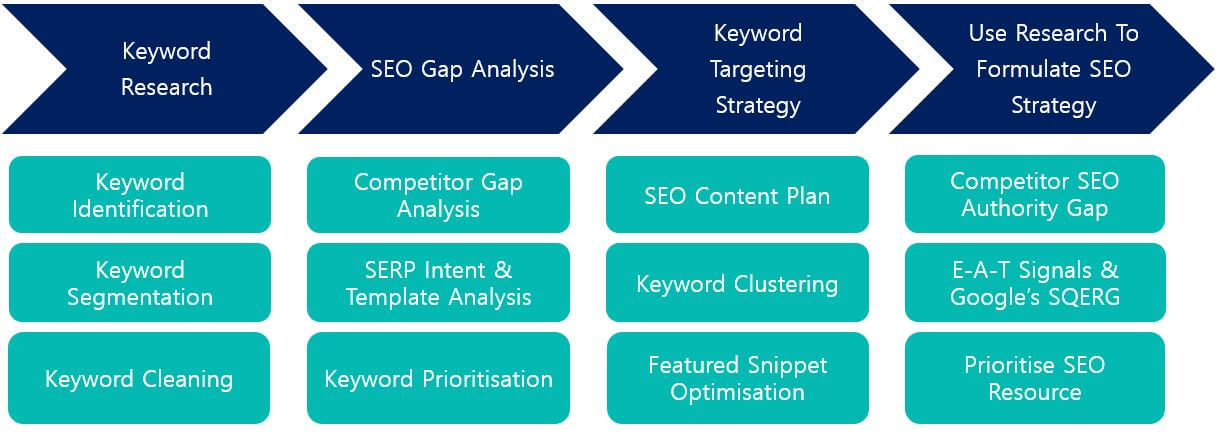
3.2. Audience Intelligence Process
To enrich your keyword intelligence with social media behavioural and interest data during the key stages of the research process, you follow this audience intelligence process.
So what are the benefits of audience intelligence? The benefits include:
- Social consumer segments analysis which derive from a larger subset of the market outside that of your brand’s customer base.
- Richer, more relevant audience insights based on behaviours and interests.
- Strategies tailored to their interests and increase likelihood of achieving KPIs.

Next, we shall explore each of these stages in more detail and explain how you can implement this process with a step-by-step guide and include examples from the UK property industry.
3.3. Keyword Intelligence and Audience Intelligence Integration
To integrate your keyword intelligence with social media data from audience intelligence platforms, you must first identify your website’s SEO competitors for your priority keyword segments. These are the websites which rank for the greatest number of keywords at the lowest average rank for a priority keyword segment.
Upload SEO competitors into an Audience Insights report, in a platform such as Audiense, to identify the social consumer segments which are active within a keyword segment. This analysis focuses on the interconnectedness of the social profiles which follow the SEO competitors to understand their shared affinities, interests and behaviours.
The diagram below demonstrates how you would integrate your keyword intelligence with audience intelligence using an example from the UK property market, whereby @ChristiesHomes is uploaded to an Audiense Insights report due to its strong performance in the ‘Luxury Property’ keyword segment and it’s status of an SEO competitor.
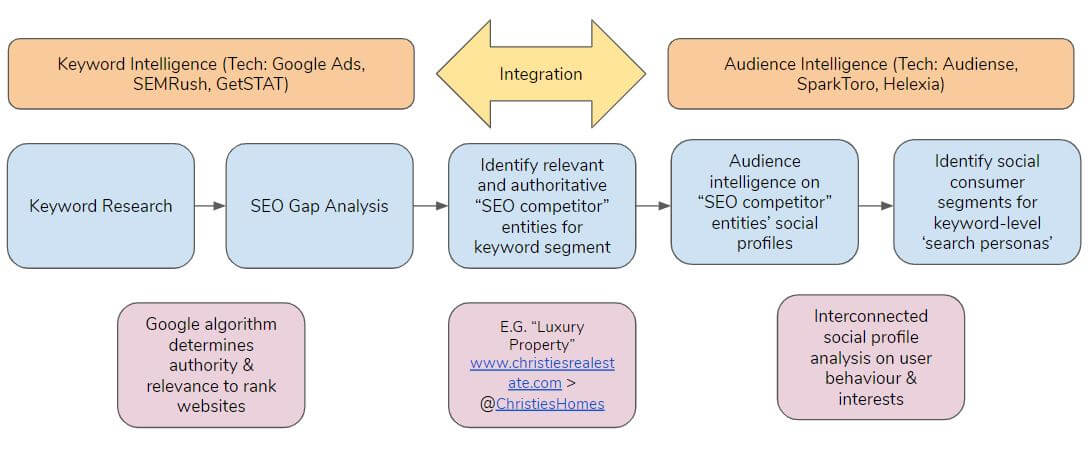
This approach will offer you a greater understanding of the interests, behaviours and influencers of the audiences within your keyword topics. Ultimately, this understanding of the community will lead to more effective content strategies using SEO topical modelling, and digital PR campaigns that generate more authoritative, relevant backlinks.
3.4. Keyword Segmentation and SEO Gap Analysis
After undertaking the keyword intelligence stages 1 and 2, you will end up with your keywords segmented into dimensions (themes) and segments within those dimensions (sub-themes). The example below is keyword intelligence gathered for the UK property industry.

In this example, not all keywords follow the ‘[X] bed property / home / flat to rent / to buy in [X location]’ search pattern as there are additional keyword segments including: 1) New Homes; 2) Luxury Properties; 3) Commercial Property.
Importantly, as an SEO you should understand that each of these keyword segments are evaluated by search engine algorithms based on different weighting factors. This will lead to each keyword segment having a different list of SEO competitors, albeit sometimes with overlap.
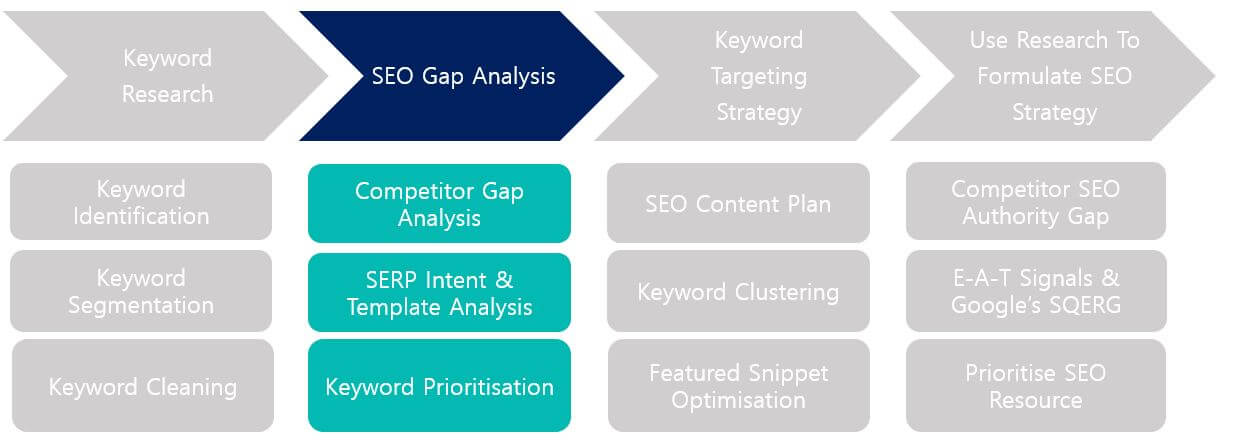
We need to develop bespoke keyword-level SEO strategies for each keyword segment to deliver strong performance. To do this, it’s integral that we better understand the interests, behaviours and influencers of relevant audiences search around a keyword topic.
To identify your SEO competitors per priority keyword segment, you will need to undertake SEO Gap Analysis, and upload your tagged keywords into a keyword ranking tracking solution. This will allow you to identify the websites that perform best per keyword segment.
Taking the ‘Luxury Property’ keyword segment, we can determine through this process that the SEO competitors for a property portal brand like Zoopla or OnTheMarket.com would be Savills, Knight Frank, Christies Real Estate and Luxury Estate. Whereas in comparison, the SEO competitors for ‘New Homes’ would include Smart New Homes, The Construction Centre and Taylor Whimpey.
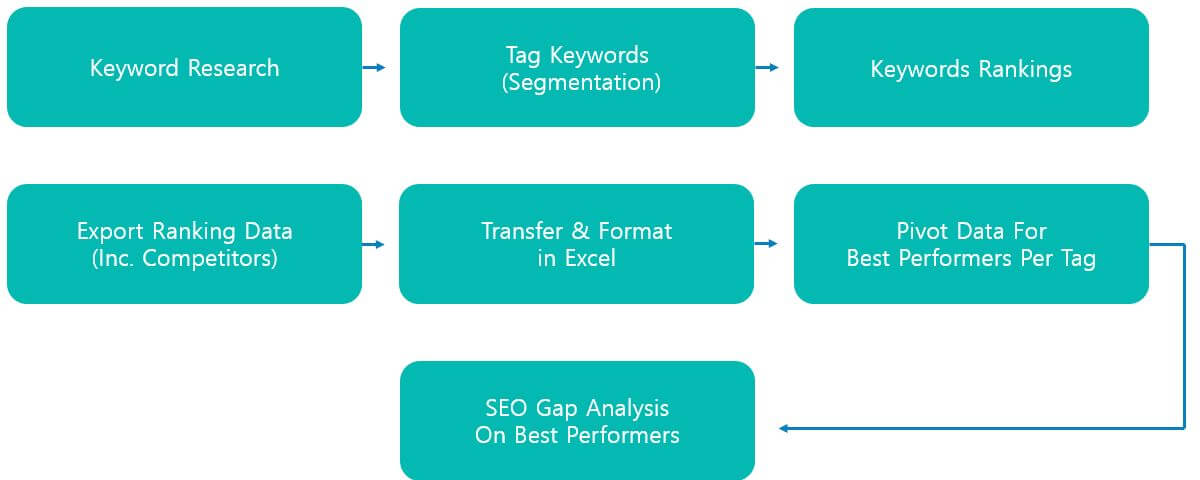
The keyword intelligence process would then identify all of the SEO competitors for the ‘Luxury Property’ keyword segment. To determine this you should analyse the total number of keywords and average rank per website.
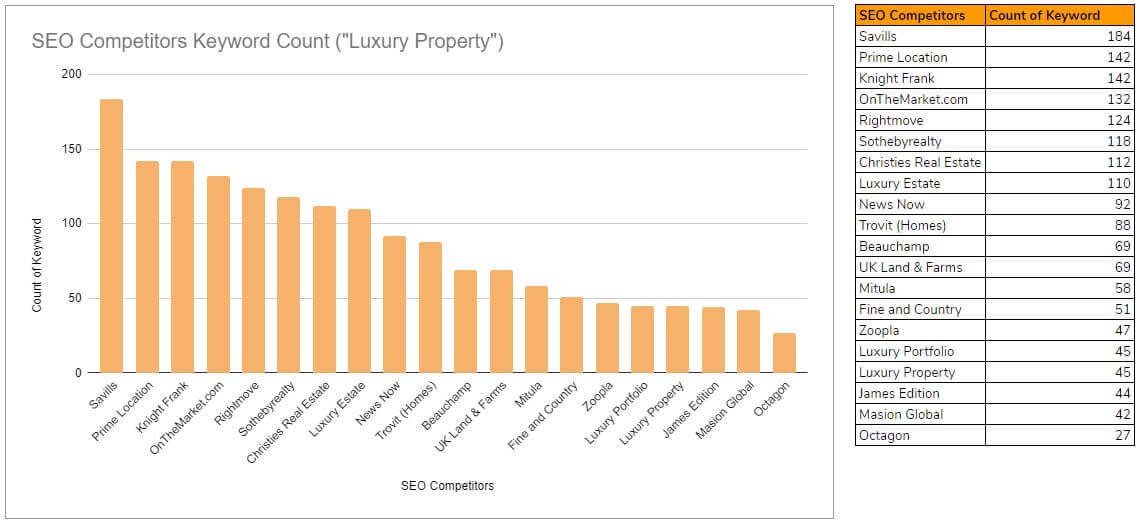
I recommend managing all of your data in Google Sheets or Excel, and then only selecting the most hyper-relevant SEO competitors to the keyword topic you’re interested in. Upload these hyper-relevant SEO competitors into the audience intelligence platform you use.
You don’t want to dilute your audience intelligence report with irrelevant entities which have social followers wider than the keyword topic you’re interested in (e.g. Wikipedia, Amazon, eBay).
For example, when creating the ‘Luxury Property’ keyword-level search audience report, you would exclude the following SEO competitors from your audience intelligence report:
- Rightmove (too broad audience)
- Zoopla (too broad audience)
- OnTheMarket.com (too broad audience)
However, you would include the following in your audience intelligence report:
- Savills (Luxury and high-end specific audience)
- Knight Frank (Luxury and high-end specific audience)
- Christies Real Estate (Luxury and high-end specific audience)
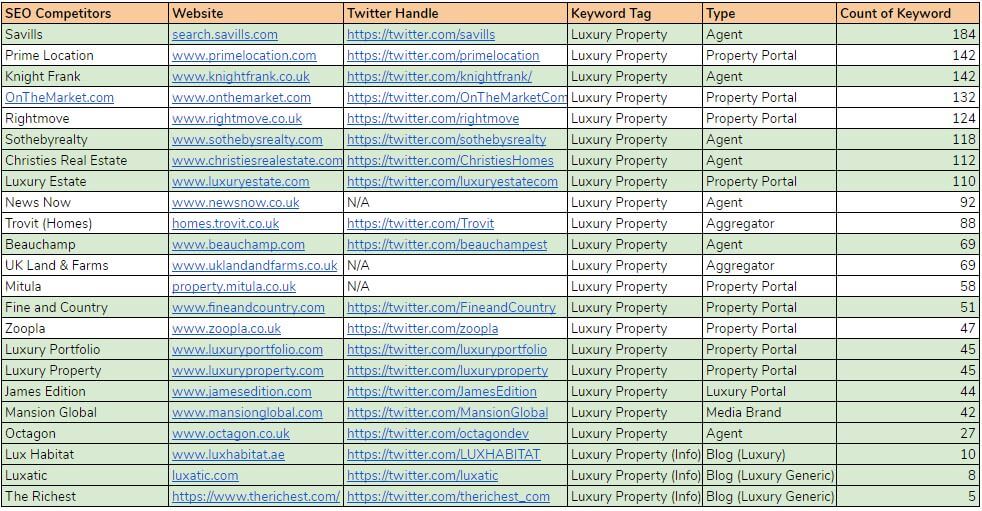
3.5. How to Upload Twitter Profiles of SEO Competitors into Audience Intelligence Technology
Now that you have identified your SEO competitors, you need to upload their associated Twitter profiles into an audience intelligence report per keyword segment. This will allow you to identify the active social consumer segments around that keyword segment.

If you were to use Audiense as your audience intelligence technology, you would select your Audience Insights report, name it as something relevant (e.g. ‘Luxury Property Search Audience’), and then select the Profile Attributes option.
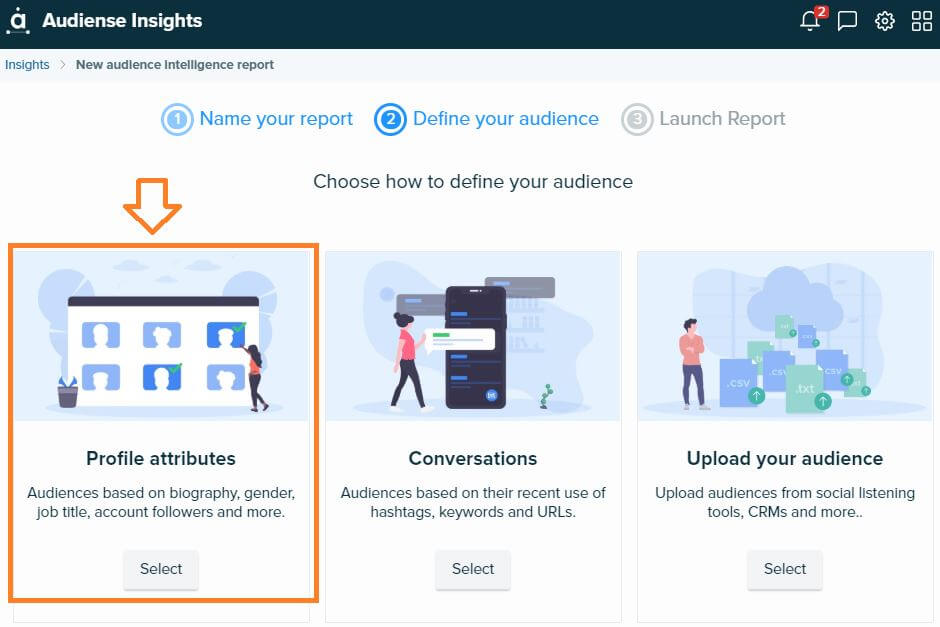
You should select the ‘Followers of’ and input the Twitter profiles of all the SEO competitors. You can review the example for the ‘Luxury Property’ keyword segment.
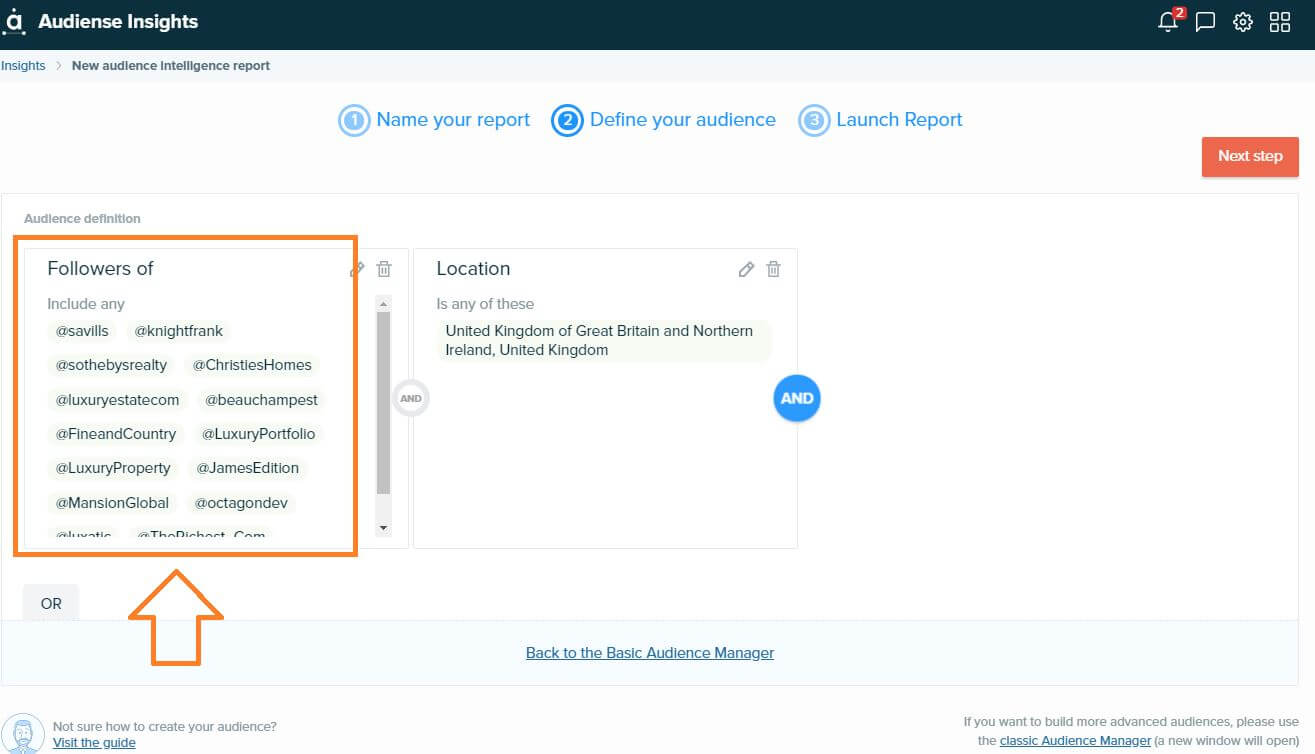
3.6. How to Analyse Your Keyword-Level Search Audience Reports
With Audiense, your report should be ready within an hour, and then you will be able to review the audience intelligence report. For the ‘Luxury Property’ keyword-level search audience example, the report has generated the following social consumer segmentation:
- ‘Letting, estate agents’
- ‘Planning, housing’
- ‘Rural , agricultural’
- ‘Real estate, commercial property’
- ‘Scotland, yacht’
- ‘South, devon’
- ‘Wales, cardiff’
So let’s take the hypothetical scenario that you wanted to understand who the niche luxury property seekers are in the UK property market. This will help to plan audience-first digital PR campaigns that appeal to their interests and have a far greater chance of being featured in relevant publications for the ‘Luxury Property’ keyword segment.
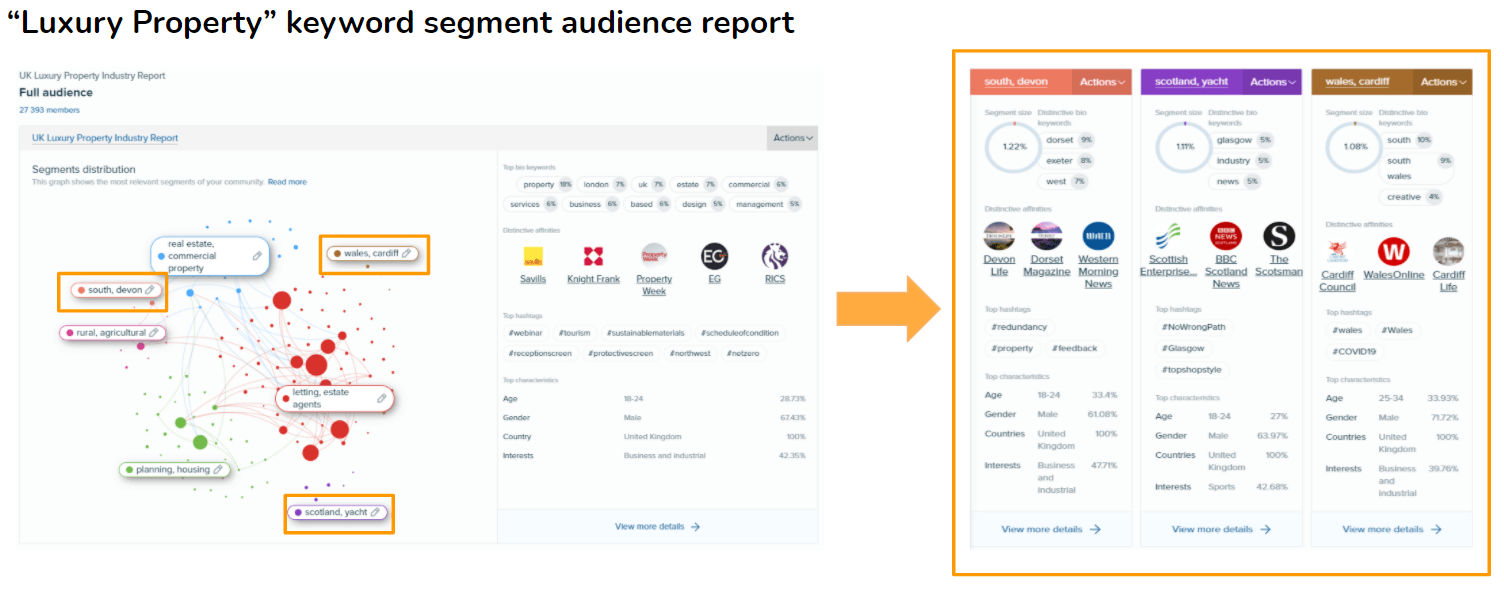
Immediately, I’ve noticed three niche social consumer segments in the audience intelligence report. These include: 1) ‘Scotland, yacht’; 2) ‘South, devon’; 3) ‘Wales, cardiff’ and each contains insights into the luxury property seeker. Each of these segments has a small total audience size, but that’s exactly what we’d expect when searching for the niche luxury segment.
Firstly, we would investigate the ‘Influencers and Brands’ section of the audience insights report, and we would do this for each social consumer segment. You should filter based on the highest affinity scores.
You should then export all of the data into Excel and begin to identify the influencer entities that have a high affinity score for these social consumer segments. This allows us to start establishing an understanding of the niche luxury property seeker’s influencers, their interests and behaviours.
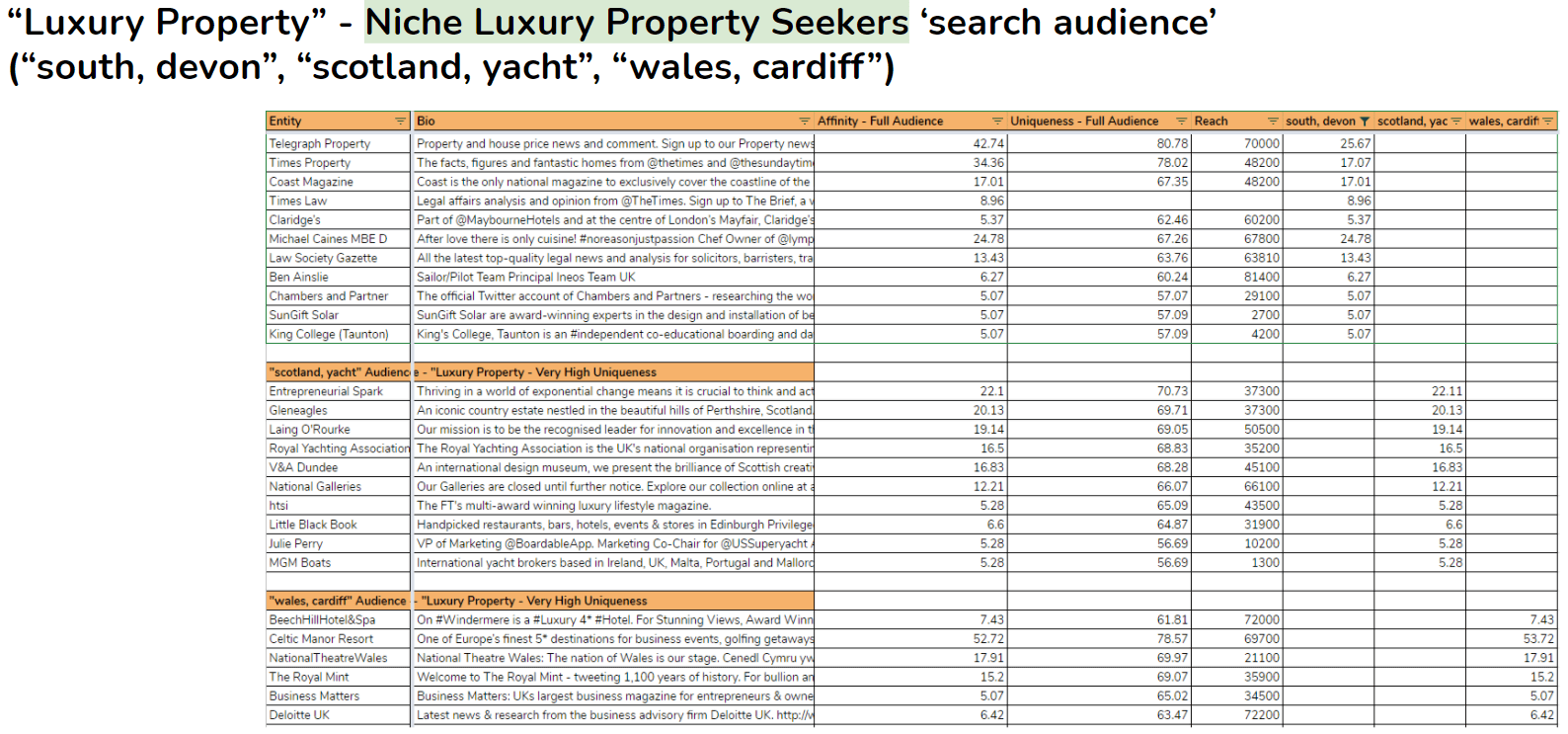
3.7. How to Identify the Search Audience Profiles from Social Consumer Segmentation
The affinity scores per influencer entity for a social consumer segment are measured based on following and engagement patterns from Twitter users that share similar characteristics. We can begin to build the profile of the luxury property seeker within the ‘Luxury Property’ keyword-level search audience.
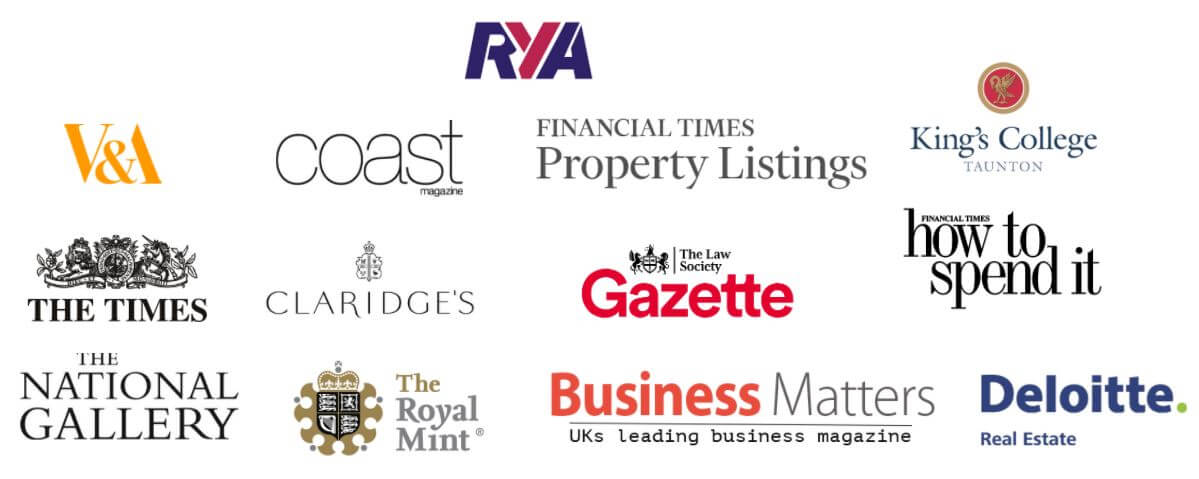
We can quickly identify the link opportunities and stimulate content ideas in line with our keyword targeting strategy by analysing the influencer entities with high affinity scores for the social consumer segments generated by the keyword-level search audience report.
Below is a visualisation of the influencer entities with the highest affinity scores for the ‘Property, estate’ social consumer segment that is active within both the ‘New Homes’ and ‘Luxury Property’ keyword-level search audience reports:
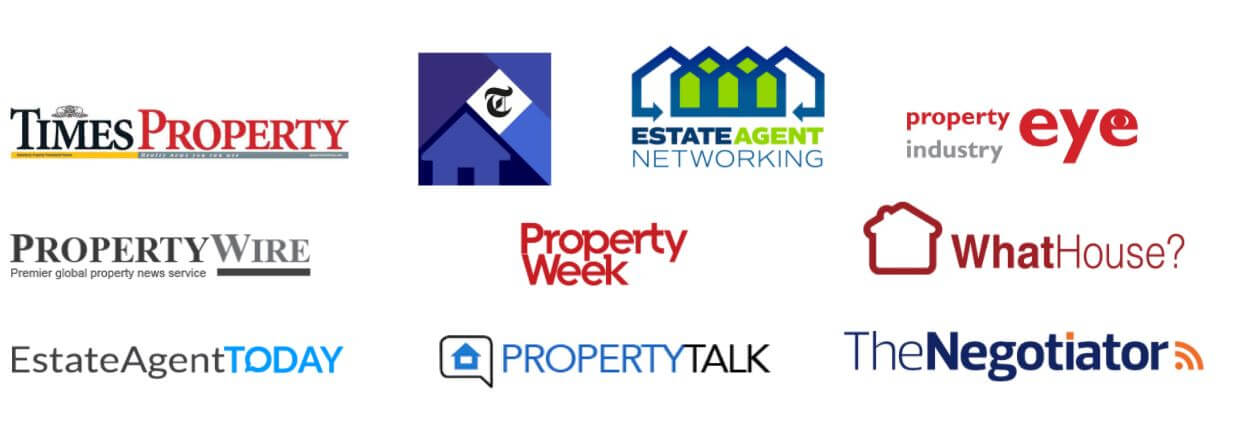
In comparison, below we have the ‘Planning, housing’ social consumer segment’s high affinity score influencer entities (this social consumer segment is active within the ‘New Homes’ keyword-level search audience):

This process enables the prospecting of hyper-relevant link opportunities and influencers at scale efficiently for each social consumer segment active within a keyword topic.
4. How Do You Optimise Towards Audience-First SEO?
You need to gather all of the insights from your integrated keyword intelligence and audience intelligence to then focus on making sure your brand is hyper-relevant to the search patterns, interests, cultures and behaviours of your target audiences to optimise towards audience-first SEO.
4.1. Identifying the Keyword Segment to Audience Segment Overlaps and Differentiation
The research should help you formulate a Keyword to Audience Matrix. You can do this by identifying the keyword segment to audience overlaps and differentiation for your target keywords.
This is an extremely powerful method of communicating with other departments within your organisation, or to your client, as to which audiences you are reaching by optimising your SEO performance for target keyword segments.
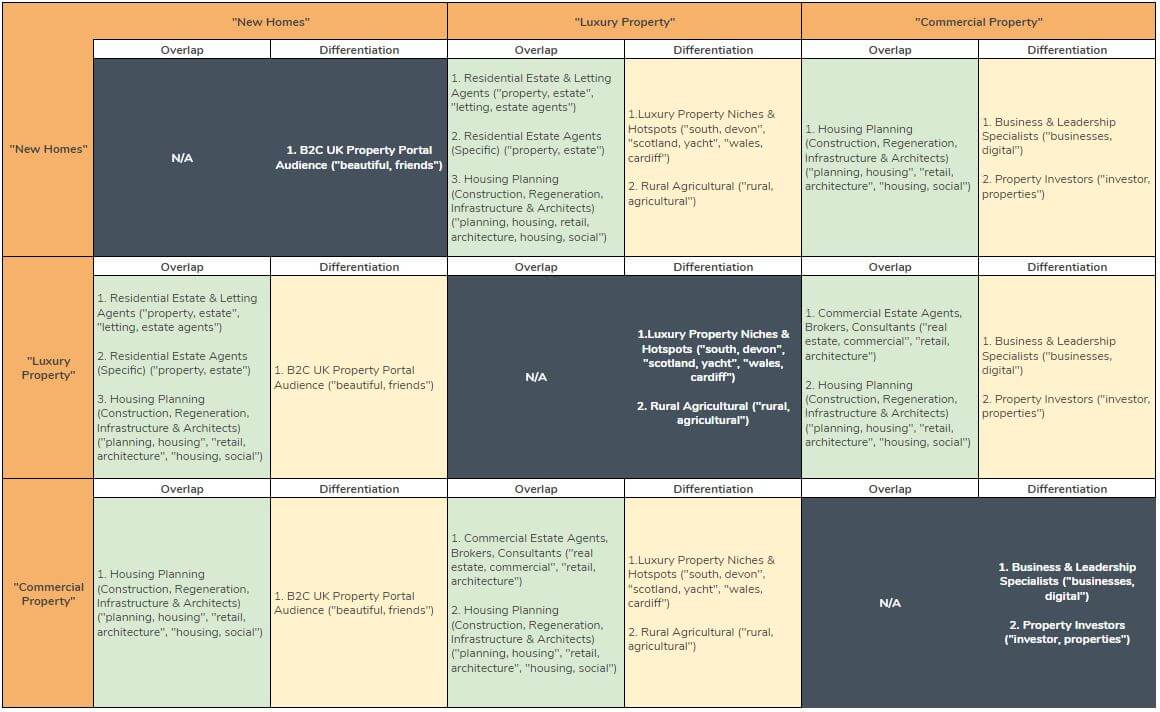
4.2. Optimise with SEO Topical Modelling Strategies
You have to focus on improving your website’s relevance and authority to a priority keyword segment to succeed at SEO. An advanced SEO tactic involves SEO topical modelling (when transactional keywords are targeted by SEO pillar pages that are supported by relevant sub-topic pages). These pages are then internally linked back to the SEO pillar page, and they must share the overall semantic theme. Search engines place more value for websites that adopt this approach as demonstrated by numerous studies.
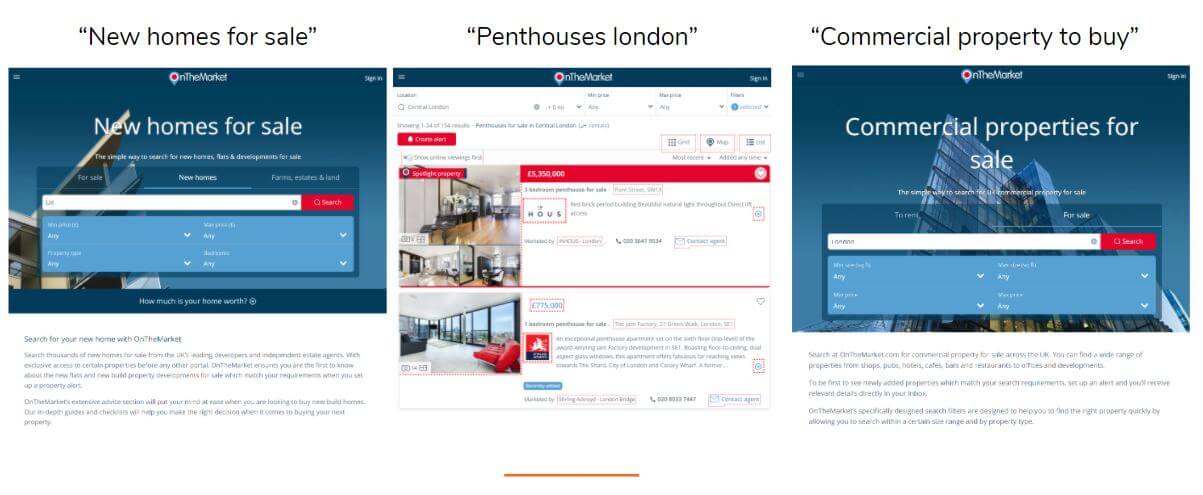
Let’s take a UK property portal as an example – OnTheMarket.com. The OnTheMarket.com team would view their SEO pillar pages for three keyword segments: 1) New Homes; 2) Luxury Property; 3) Commercial Property, as needing to be supported by publishing new, relevant content to each keyword topic. However, it’s important for this content to be relevant to the changing interests and behaviours of the audience segments that search around each keyword topic.
When targeting the ‘New Homes’ keyword segment, you can see how you could align your keyword targeting strategy with relevant audience segment interests to develop an SEO topic cluster. These content articles don’t focus on optimising for evergreen informational keywords, as these quickly become stale, ‘copy-cat’ content, and instead they stay hyper-relevant to the ‘New Homes’ conversations within the UK property industry. These articles are however internally linked to the SEO pillar page for ‘New Homes’, and are more likely to generate backlinks and pass link equity across to the ‘money page’.
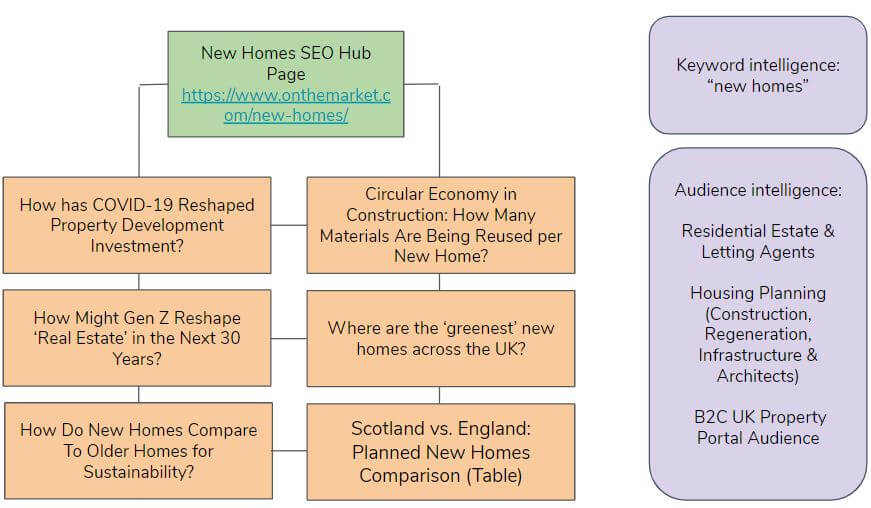
4.3. Use Social Listening of Influencer Entities to Generate Content and Digital PR Campaign Ideas
Upload the top influencer entities as identified in your keyword-level search audience report for each social consumer segment into a social listening platform. We use Pulsar and it’s TRAC search function to do this. The result? You’ll be setting up an insights feed that can help you generate a stream of content and digital PR campaign ideas.
Social listening allows you to gather real time tweet data for the most influential entities based on affinity scores for the audiences that are most active within your priority keyword topics.
This ultimately means you can plan content and digital PR campaigns with a much greater chance of success, whilst remaining hyper-relevant and delivering more SEO value with each link obtained.
I’ve listed some examples of the insights generated from TRAC search within Pulsar for some social consumer segments within various keyword-level search audience reports for the UK property market.
Example 1: ‘Residential Estate Agents’ Search Audience – Pulsar TRAC
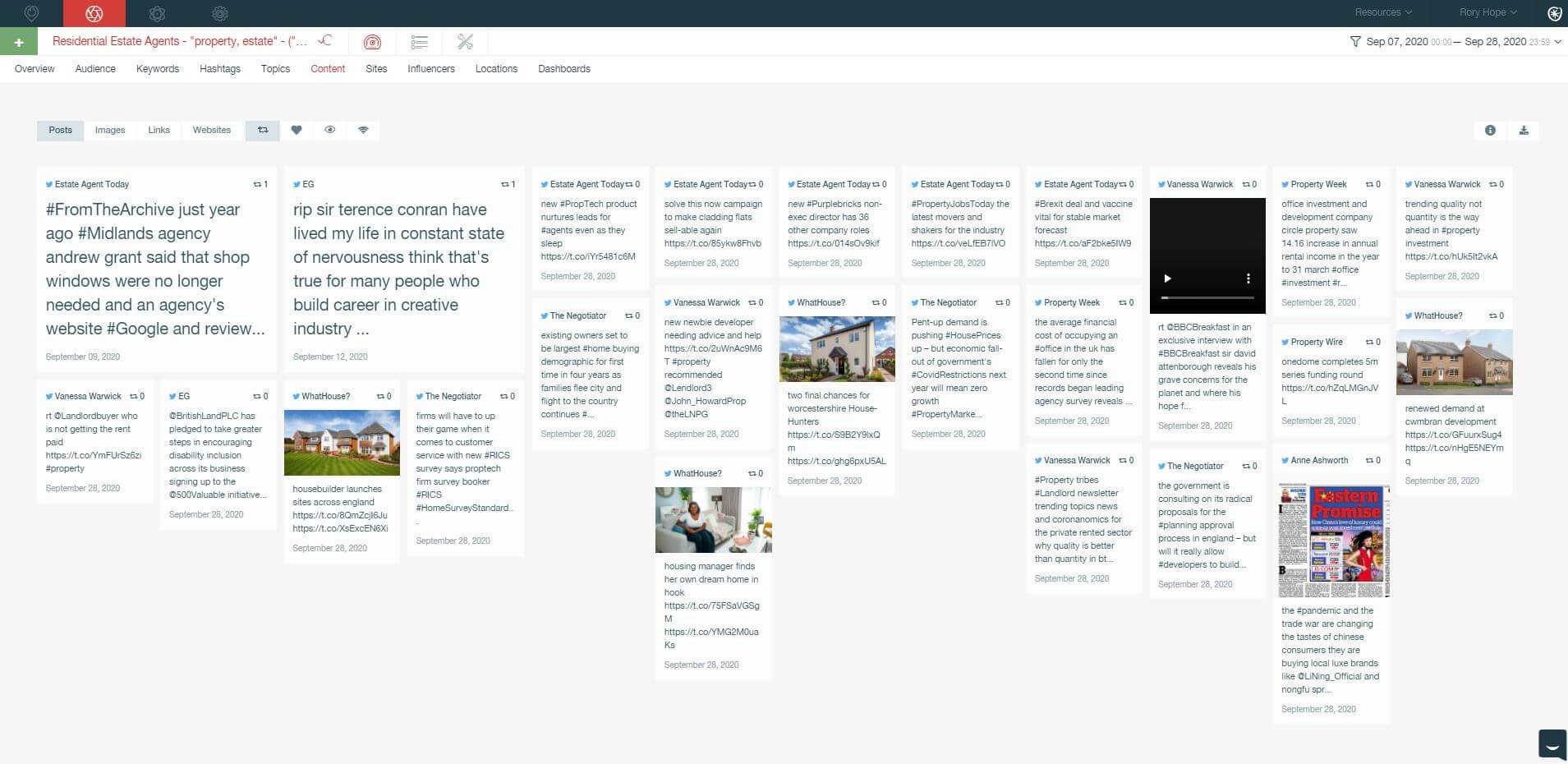
Example 2: ‘Commercial Property Estate Agents’ Search Audience – Pulsar TRAC
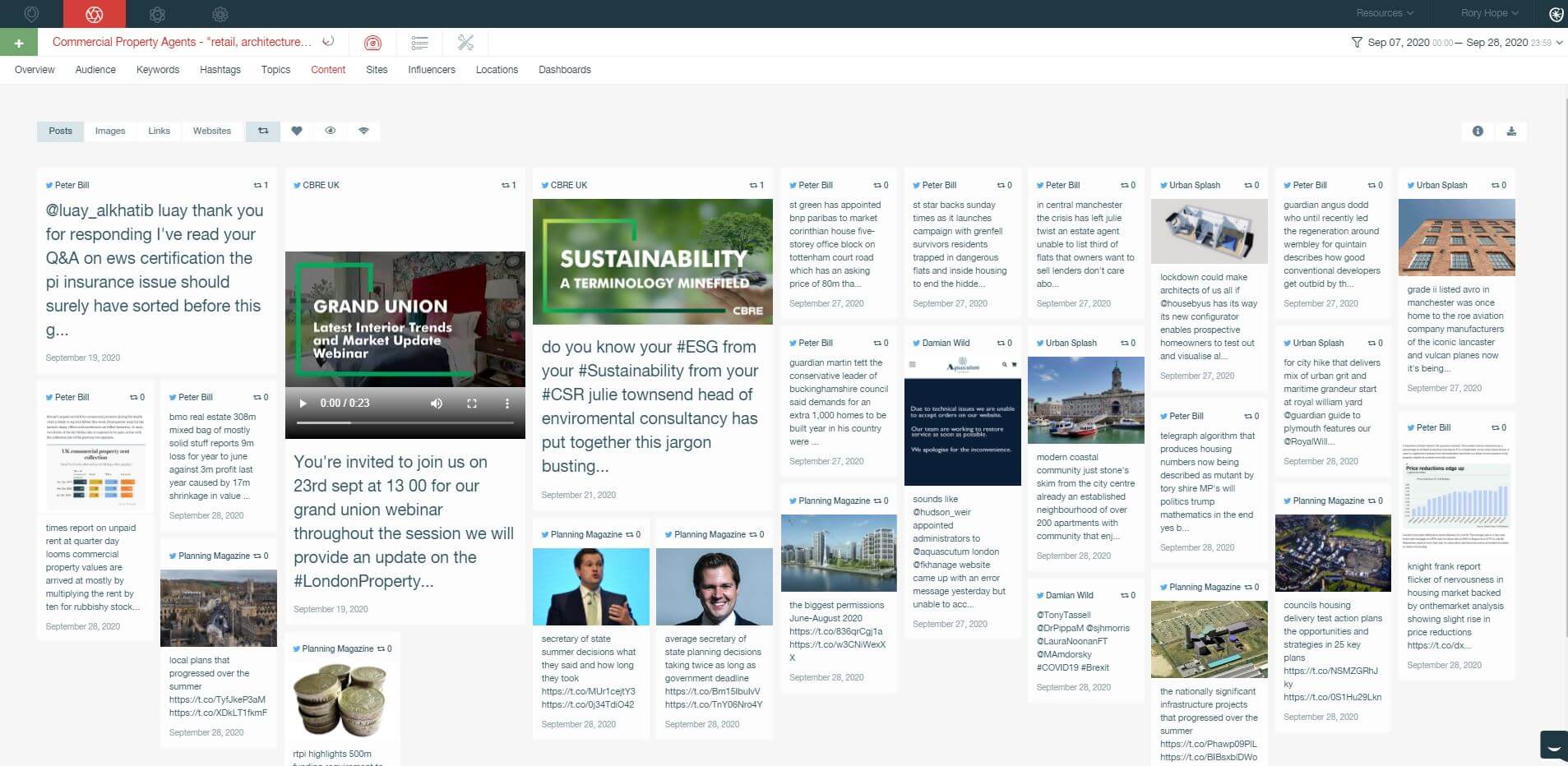
Example 3: ‘Housing Planning’ Search Audience – Pulsar TRAC
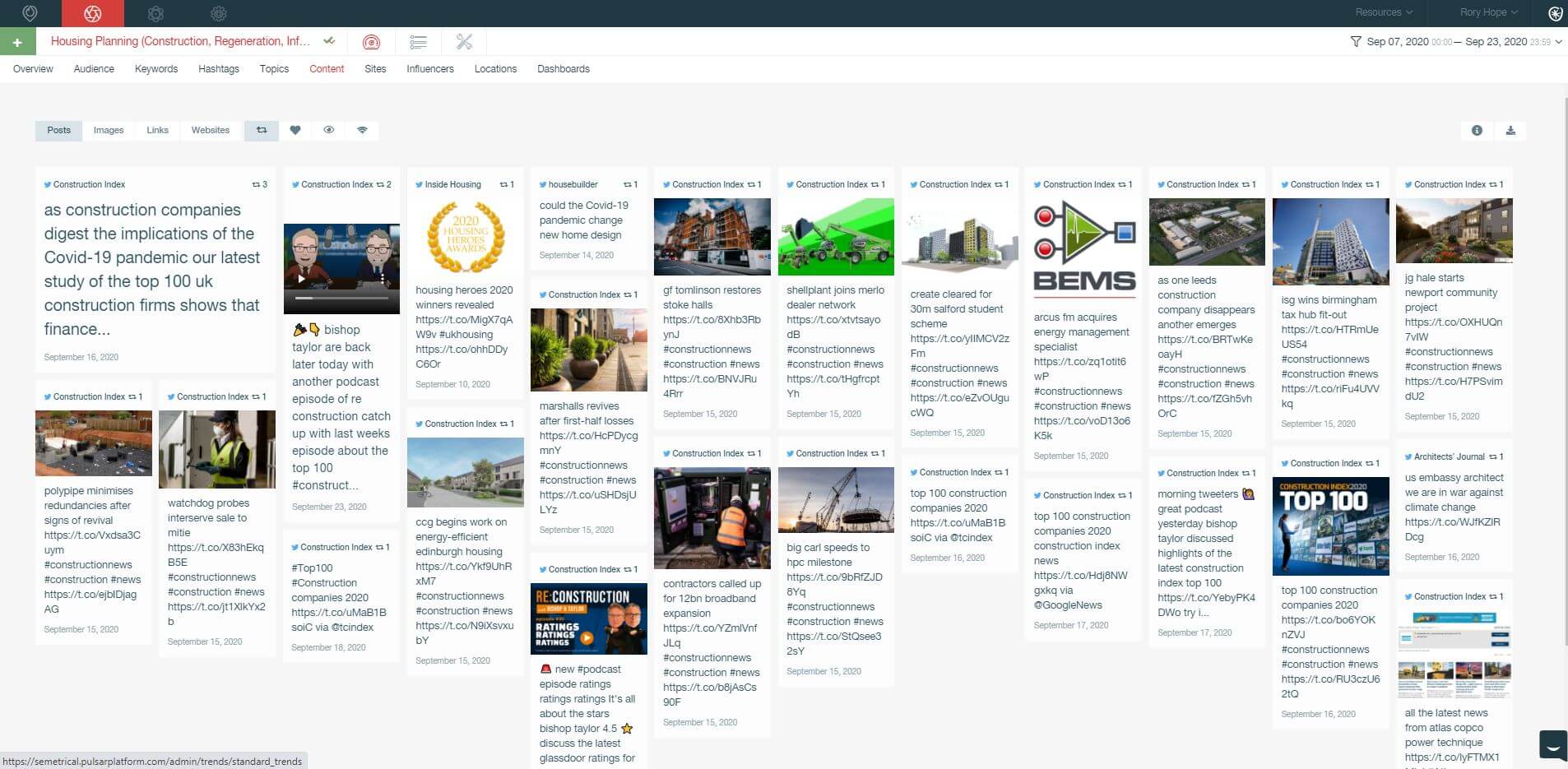
Example 4: ‘Luxury Property’ Search Audience – Pulsar TRAC
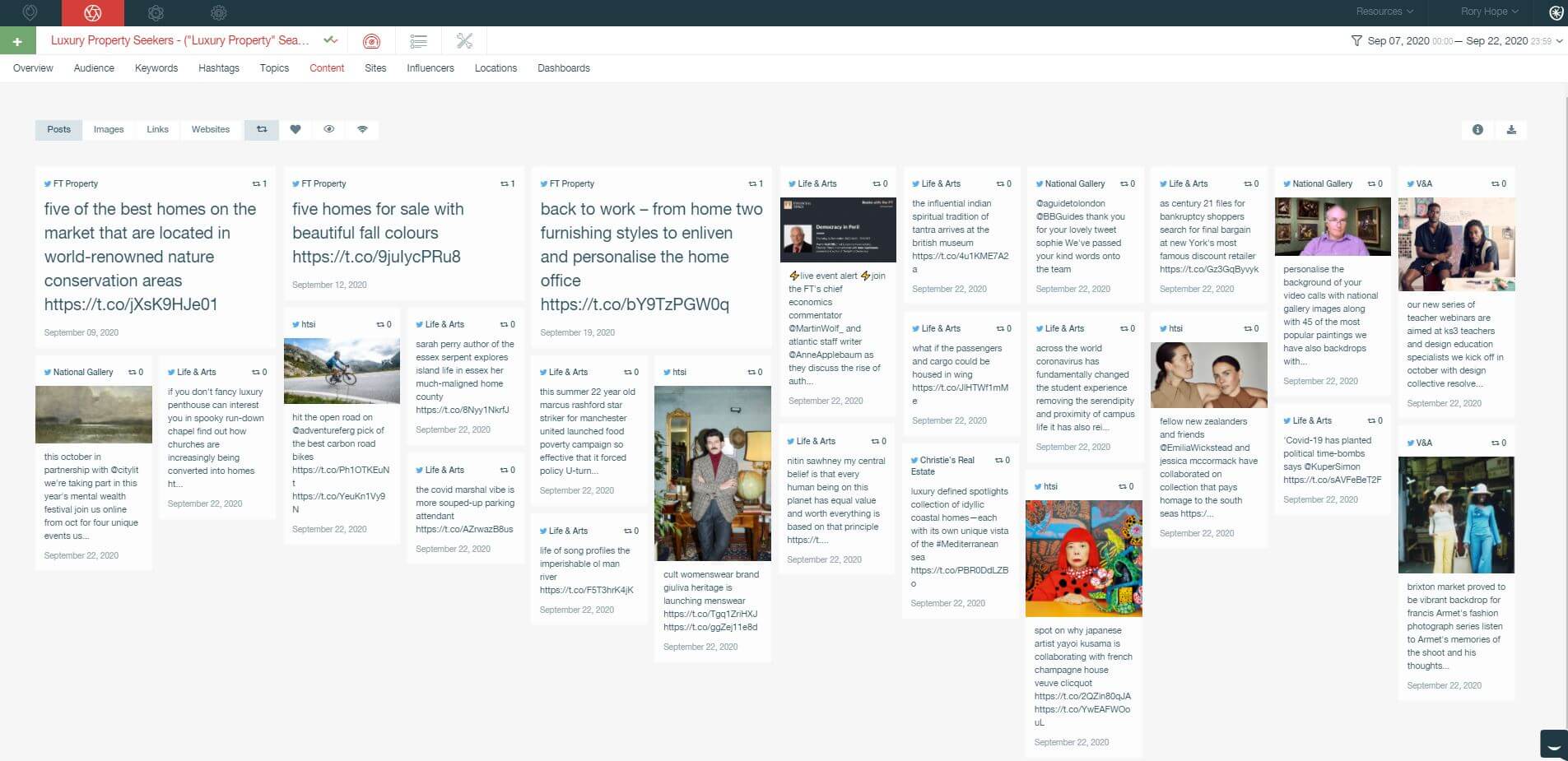
Tracking the tweets of high-affinity score entities relevant to social consumer segments or an overall keyword-level search audience empowers you to plan more relevant and engaging ideas that will directly impact your SEO performance positively.
Below are two examples.
We can identify the shareable content topics within the ‘New Homes’ keyword segment as:
- Sustainability
- Politics
- Business & Leadership
- Design & Architecture
- Insurance & Risk
- Property Investment
For the ‘Luxury Property’ keyword segment, the most shareable content topics for the audiences are:
- Wellness
- Prestigious events
- Specialism
- Narrative & history
- Exclusivity
- Arts, culture and heritage
- Technology
- Law
5. How to Coordinate an Audience-First SEO Strategy?
To coordinate your audience-first SEO strategy you must set up a suitable technology stack, including an SEO tool like SEMRush, a ranking tracking tool like GetSTAT and decide upon which audience intelligence technology to use. I have experience using Audiense and that’s the technology we’ve outlined in this article.
Final Thoughts
You can then follow this step-by-step guide, and it’s important to undertake your keyword intelligence before uploading SEO competitors into an audience intelligence technology to generate the best results.
By following this process, you will be able to identify which keywords are relevant to your business, products and services and gain a better understanding of the audiences that are active within those keyword segments.
This will lead to a better coordinated SEO strategy with enhanced audience insights that are useful for establishing more relevant and engaging content and digital PR campaigns.
It’s time to coin the term ‘audience-first SEO’.


